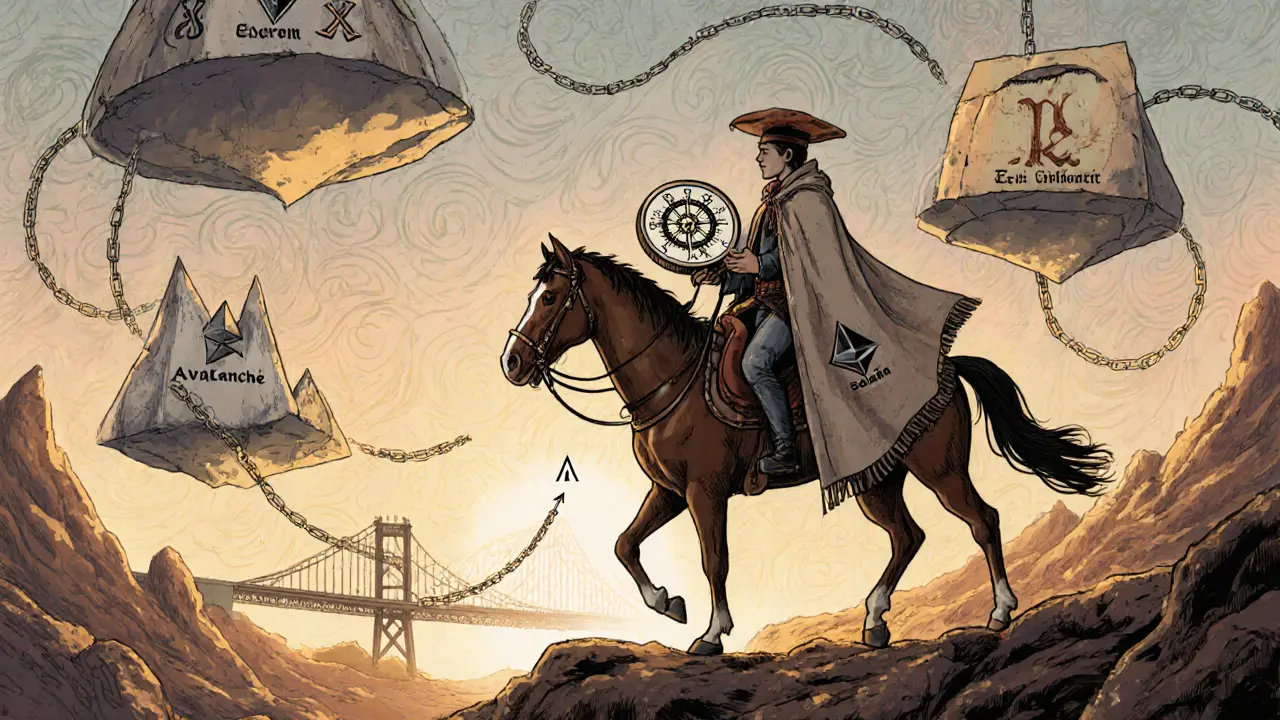Cross-Chain Swap Calculator
Swap Calculator
Calculate how much you'd receive when moving assets across chains using Elk Finance
Results
If you stake ELK tokens, you'll receive a 50% fee rebate on this transaction. This could save you 0.00 in fees.
Note: Actual values may vary based on network congestion and real-time liquidity. This tool estimates based on standard Elk Finance fees.
How This Works
Elk Finance routes your swap across multiple chains to find the best path. This calculator estimates:
- Swap Fee - Standard 0.3% fee for every transaction
- Gas Fees - Paid to Avalanche network for transaction processing
- Staking Rebate - Up to 50% fee discount for ELK token stakers
Most crypto users know the pain of moving assets between blockchains. You want to swap ETH for SOL, but instead of one click, you’re stuck bridging, waiting for confirmations, then swapping again on another chain. It’s slow. It’s expensive. And it’s frustrating. Elk Finance promises to fix that - all in one transaction, across 15+ chains, including Avalanche. But does it actually work in 2025? Or is it just another DeFi project with big claims and tiny volume?
What Elk Finance Actually Does
Elk Finance isn’t a traditional exchange. You won’t find order books, margin trading, or customer support lines that answer calls at 3 a.m. Instead, it’s a decentralized router. Think of it like a GPS for crypto. You tell it: ‘Move 100 USDC from Ethereum to Solana.’ It figures out the cheapest, fastest path - splitting the swap across multiple liquidity pools on different chains, using its own smart contracts. No manual bridging. No multiple approvals. Just one click.
It works on Avalanche, Ethereum, BNB Smart Chain, Solana, Polygon, Fantom, TRON, and eight others. Each chain has its own set of smart contracts linked by Elk’s routing engine. That engine checks real-time liquidity across all connected networks and finds the best route - sometimes even splitting your swap into three smaller trades to avoid slippage. It’s not magic, but it’s clever engineering.
The Avalanche Version: What You Get
On Avalanche, Elk Finance is barebones. As of October 2025, there are only four tokens available for trading: ELK, WAVAX, USDC.e, and WETH.e. That’s it. Six trading pairs total. The most active pair is ELK/WAVAX, with $594 in 24-hour volume. Total volume on Avalanche? Just $886.67. That’s down 62% from the week before.
Compare that to Pangolin, Avalanche’s top DEX, which moves $22 million daily. Or even Uniswap, which handles over $1.2 billion in volume on Ethereum. Elk Finance on Avalanche isn’t competing for volume - it’s competing for attention. The low numbers aren’t a bug; they’re a reality check. This isn’t a place to trade your whole portfolio. It’s a tool for specific cross-chain moves.
How ELK Token Works - And Why It Matters
The ELK token is the glue holding this system together. It’s not just a governance token. If you stake ELK, you get up to 50% fee rebates on every swap. That’s huge. Most DEXs charge 0.3% per trade. With a 50% rebate, you’re paying just 0.15%. For frequent users, that adds up fast.
Stakers also earn rewards from liquidity mining. Elk allocates 25 million ELK tokens to liquidity providers - meaning if you add ELK/WAVAX pairs to the pool, you earn more ELK. There’s also a USD-pegged stablecoin (not USDC) that’s used to pad liquidity pools, reducing slippage on low-volume swaps. And here’s the kicker: 30 million ELK tokens are locked in a community vault, controlled by token holders. That’s a rare move. Most teams dump their tokens early. Elk’s team has 20 million vested over four years. That’s a signal they’re in it long-term.
But here’s the problem: only 15% of protocol revenue goes to buybacks. That’s low. Other DeFi platforms use 30-50%. Some analysts say ELK’s value is tied to usage. Others say it’s mostly speculative. The truth? It’s both. If Elk Finance grows, ELK becomes more useful. If it doesn’t, the token has little intrinsic value.

How It Compares to XY FINANCE and Others
Elk Finance isn’t alone. XY FINANCE is its closest rival. Both do cross-chain swaps. Both support MetaMask and WalletConnect. Both work on Avalanche, Ethereum, and Solana. But Elk supports 15+ chains. XY FINANCE supports 10+. That extra 50% coverage matters if you’re moving assets from TRON to Fantom, or Polygon to Scroll.
Elk’s routing engine is also more aggressive. It splits trades more often to avoid slippage. XY FINANCE tends to use direct paths. That means Elk might be slower on simple swaps, but better on complex ones. If you’re swapping a low-liquidity token like a new memecoin from Ethereum to Solana, Elk has a better chance of finding a path. XY might just fail.
But volume tells the real story. XY FINANCE does $12.7 million in daily volume. Elk Finance? Less than $1 million total across all chains. That’s a 12x gap. Why? Because users trust volume. They go where the liquidity is. Elk’s biggest weakness isn’t tech - it’s trust.
Who Should Use Elk Finance?
You should use Elk Finance if:
- You regularly move assets between obscure blockchains (e.g., Fantom to TRON)
- You’re tired of bridging and swapping in three separate steps
- You hold ELK and want to reduce swap fees
- You’re experimenting with cross-chain DeFi and don’t need high volume
You should NOT use Elk Finance if:
- You’re trading large amounts of ETH, SOL, or USDC - use Uniswap or PancakeSwap
- You need fast execution during high volatility - Elk’s routing can lag during congestion
- You’re new to DeFi - the interface assumes you know what a liquidity pool is
- You expect customer service - support is live chat only, no phone, no email
Real users on Reddit say: ‘The ability to swap from ETH to SOL in one transaction saved me three separate bridge transactions.’ That’s the real win. But they also say: ‘I couldn’t swap my tiny amount of a new token because the pool was too shallow.’ That’s the trade-off.
Getting Started on Avalanche
Here’s how to use Elk Finance on Avalanche in 2025:
- Get a wallet that supports Avalanche - MetaMask is easiest. Add the Avalanche network if you haven’t already.
- Buy some WAVAX (Avalanche’s native token) to pay for gas. You’ll need at least 0.1 WAVAX.
- Go to app.elk.finance and connect your wallet.
- Select ‘Avalanche’ as your source chain. Pick a token you own - say, USDC.e.
- Choose ‘Avalanche’ again as the destination (you’re swapping within Avalanche) or pick another chain like Solana.
- Enter the amount. Click ‘Swap.’
- Approve the token. Then approve the swap. Confirm both in your wallet.
The whole process takes 15-20 minutes if it’s your first time. After that, it’s under 5 minutes. No mobile app. No desktop app. Just a web interface. It works on Chrome, Firefox, and Edge. No Safari support yet.

Is Elk Finance Safe?
It’s not a centralized exchange. That means no hacks of user funds. No KYC. No frozen accounts. All trades happen on-chain through audited smart contracts. The code is open-source on GitHub. Three independent audits have been done - by CertiK, PeckShield, and Hacken. No critical vulnerabilities found.
But here’s the catch: cross-chain protocols are complex. The more chains you connect, the more attack surfaces you create. There have been rare cases where routing failed during network congestion, and funds got stuck in a vault for hours. The team says it’s a bug, not a hack. They fixed it within 48 hours. Still - if you’re moving $10,000, you might want to test with $100 first.
Future Roadmap: What’s Next?
Elk Finance isn’t standing still. In June 2025, they integrated with Avalanche’s subnet architecture. That means faster routing and lower fees on Avalanche-specific swaps. By Q1 2026, they plan to add Arbitrum, Optimism, and zkSync. That’s smart. Those are the fastest-growing Layer 2s.
They’re also working on a new stablecoin that’s fully collateralized by real-world assets. If that launches, it could boost liquidity across chains. And they’re planning to list ELK on more centralized exchanges. Right now, it’s on Binance and HTX. More listings mean more users.
But the biggest hurdle? Adoption. Elk Finance needs more users to create more liquidity. More liquidity means better swaps. Better swaps mean more users. It’s a chicken-and-egg problem. Right now, they’re stuck in the early stage.
Final Verdict: Worth It?
Elk Finance on Avalanche isn’t the best DEX. It’s not even close. But it’s the only DEX that lets you swap from Ethereum to Solana in one click without bridging. That’s unique. If you need that feature, it’s invaluable.
For everyone else? Stick with Pangolin, Trader Joe, or Uniswap. They have more liquidity, better UI, and lower risk.
Elk Finance is a niche tool. It’s not for trading. It’s for moving. And if you’re someone who moves crypto between chains every week, it’s worth a try. Just don’t expect miracles. And never put more than you’re willing to lose.
Is Elk Finance a centralized or decentralized exchange?
Elk Finance is a decentralized exchange (DEX). It runs entirely on smart contracts across multiple blockchains. There’s no central company holding your funds. You connect your wallet - like MetaMask - and trade directly on-chain. No KYC, no withdrawals to a bank account, no customer service team that can reverse transactions.
Can I trade ELK for other tokens on Avalanche?
Yes, but only a few options. On Avalanche, you can swap ELK for WAVAX, USDC.e, and WETH.e. That’s it. There are only six trading pairs total on the Avalanche version. If you want to trade ELK for other tokens like SOL or ETH, you need to swap to those chains directly. The platform doesn’t list every token - only those with enough liquidity to make swaps viable.
Does Elk Finance have a mobile app?
No, Elk Finance has no mobile app. The entire platform is web-based. You access it through your browser on desktop or mobile. It works fine on phones, but you’ll need a wallet like MetaMask or WalletConnect already installed. There’s no native iOS or Android app, and none are planned for 2025.
What’s the minimum amount I can swap on Elk Finance?
There’s no official minimum. You can swap as little as 0.0001 ELK or 0.001 USDC.e. But in practice, you need enough to cover gas fees. On Avalanche, that’s about 0.05-0.1 WAVAX. If your swap amount is too small, the fees might eat up most of your value. For example, swapping $1 worth of ELK might cost $0.50 in gas - not worth it.
How do I earn rewards with ELK tokens?
You can earn ELK rewards in two ways. First, by staking ELK - you get up to 50% fee rebates on every swap. Second, by adding liquidity to ELK/WAVAX or other pairs - you earn a share of trading fees and additional ELK tokens from the liquidity mining pool. Rewards are distributed weekly. The more ELK you stake or lock in liquidity, the higher your rewards.
Is Elk Finance safe for large trades?
Not recommended. Elk Finance’s liquidity is thin on most pairs. Swapping more than $5,000 at once could cause severe slippage - you might get far less than expected. Also, cross-chain routing can fail during network congestion. For large trades, use centralized exchanges or high-volume DEXs like Uniswap. Elk Finance is designed for small, frequent swaps between chains - not big moves.
Why is trading volume so low on Elk Finance?
Because most users don’t need it. The average crypto trader swaps within one chain - like ETH to USDC on Ethereum. Elk Finance solves a niche problem: moving assets between chains. That’s a small group. Also, it’s new, lacks marketing, and has no big-name partnerships. Without volume, liquidity stays low. Without liquidity, users don’t come. It’s a cycle the team is trying to break - but slowly.
Can I use Elk Finance without owning ELK tokens?
Yes, you can use the platform without owning ELK. You can swap any supported token without staking. But you’ll pay full swap fees - no rebates. If you plan to use it regularly, buying and staking ELK saves money over time. For one-time swaps, it’s not necessary.
What happens if a cross-chain swap fails?
If a swap fails, your funds are never lost. They’re returned to your wallet. Elk Finance uses a non-custodial model - your assets never leave your control. If the routing engine can’t find a path, or if one leg of the swap times out, the entire transaction is rolled back. You’ll just lose the gas fees you paid to initiate it. That’s standard in DeFi.
How does Elk Finance make money?
Elk Finance takes a 0.3% fee on every swap - same as most DEXs. Half of that fee (0.15%) goes to liquidity providers. The other half (0.15%) goes to the protocol treasury. That treasury funds development, marketing, and future upgrades. It does not pay dividends or buy back tokens regularly. Revenue is low because volume is low. The team’s goal is to grow usage so the treasury can fund expansion.
